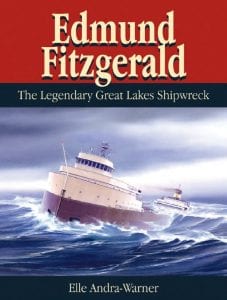Most of us know the Gordon Lightfoot song about the Edmund Fitzgerald. It closely chronicles the sinking of the ship in a legendary, wild November 10, 1975, storm. All 29 crew members were lost. A tragedy reported around the world.
But why did this happen? Study after study was conducted into this horrific accident. Report after report was issued. But speculation into this sinking continues. How could a modern, state-of-the-art ship sink in minutes? Was it human error? A faulty hull design? A combination of both? Or something else?
And what about the other Fitzgerald ships that sailed the Great Lakes?
On November 14, 1883 the E. Fitzgerald wrecked at Long Point, Lake Erie in a fierce November storm. She was 300 yards from shore when the crew of six to eight men lowered the ship’s yawl and piled into it. As townsfolk and rescue crews watched , the yawl capsized and the men were lost.
The second Fitzgerald to sail the Great Lakes was the R.P. Fitzgerald. Built in 1887, she was sunk accidentally on October 3, 1918, by the barge Grampion. Considered a total loss, she lies in 22 feet of water directly in front of the dock of the Northern Navigation Company.
The third Fitz., the W.E. Fitzgerald, was built in 1906 and sailed the Great Lakes until she was scrapped at Humberstrone, Ontario in 1971. But she also sufferred a near miss.
Before going on too long with this, and especially in light of the mermen and sea monsters that are “officially” reported in the book entitled Edmund Fitzgerald
by Elle Andra- Warner, you need to go get the book. It’s a great read. Filled with interesting facts about the Fitzgerald family and the great lakes boats that sailed this fresh water sea, the book will entertain you and inform you.
Produced locally by North Shore Press, the book can be found at local bookstores. The author lives in Thunder Bay, Ontario and obviously has a passion for this topic.
Like many things, the answer to this mystery may never be solved. But it is interesting to learn more about the history of Great Lakes shipping and the sailors who ply these waters. You will come away respecting the men and women who transport goods across the Great Lakes. They have a hard job. Sometimes one that takes their lives.



Loading Comments